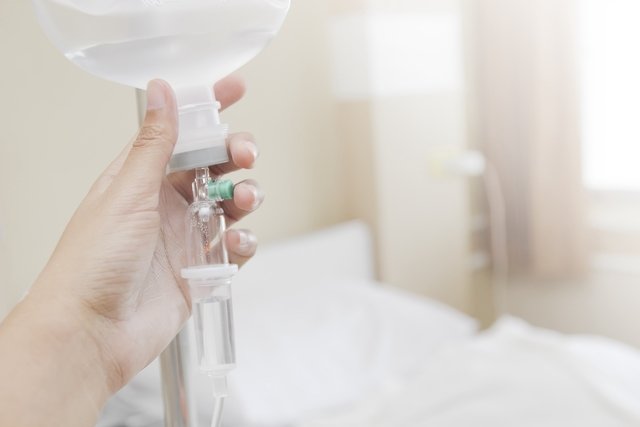Amphotericin B is an antifungal indicated for the treatment of serious fungal infections or systemic mycosis, such as disseminated candidiasis, blastomycosis or cryptococcosis, or for the treatment of fever in people with neutropenia, when the cause of the fever is not known.
This medication is for injectable use and acts by preventing the mechanism of action of fungi, as it alters the permeability of their membrane, thus reducing the likelihood of complications in fungal diseases.
Amphotericin B can be found in hospitals in the form of conventional amphotericin B (Anforicin B), amphotericin B lipid complex (Abelcet) or liposomal amphotericin B (Ambisome) and must be applied into the vein by the nurse, under medical supervision. Furthermore, this remedy can be found in combination with tetracycline + amphotericin B, in the form of an ointment for vaginal use.

What is it for
Amphotericin B is indicated for the treatment of serious fungal infections or systemic mycoses, such as:
- Disseminated candidiasis;
- Fungal septicemia;
- Cryptococcosis or cryptococcal meningitis;
- Blastomicose norte-americana;
- Coccidioidomycosis and paracoccidioidomycosis;
- Aspergilose;
- Histoplasmosis;
- Mucormycosis or fusariosis;
- Cutaneous or visceral leishmaniasis;
- Zygomycosis.
Furthermore, amphotericin B may be indicated for the treatment of febrile neutropenia, when people with low levels of neutrophils in their blood have a fever of unknown origin.
This medicine must be used with the recommendation of an infectious disease specialist in hospitals, being applied directly into the vein by the nurse, in the doses and for the treatment time determined by the doctor.
Make an appointment with an infectious disease specialist in the nearest region:
Taking care of your health has never been easier!
How to use
Conventional amphotericin B, liposomal amphotericin B and lipid complex amphotericin B must be used intravenously, that is, applied into the vein by nurses in hospitals, under medical supervision. Tetracycline + amphotericin B vaginal cream should be used by applying the ointment to the vagina.
1. Conventional amphotericin B
Conventional amphotericin B (Amforicin B) is found in powder form to be reconstituted in water for injections to obtain a 5 mg/mL solution and then added to a 5% glucose solution.
Doses of conventional amphotericin B for adults vary according to the condition being treated and include:
- Disseminated or severe candidiasis: doses for adults range from 0.4 to 0.6 mg/kg/day, for 4 weeks or more, according to medical advice;
- Cryptococcosis: doses for adults are 0.3 mg/kg/day, for 4 to 6 weeks, or for 1 month until culture tests are negative. In immunosuppressed adults or those with cryptococcal meningitis, higher doses may be necessary;
- Coccidioidomicose: doses vary from 1.0 to a maximum of 1.5 mg/kg/day;
- Blastomicose: doses range from 0.3 to 1 mg/kg/day;
- Histoplasmosis: recommended doses range from 0.5 to 1 mg/kg/day;
- Sporotrichosis: the total dose is up to 2.5 g for a treatment time of up to 9 months;
- Aspergilose: doses vary from 0.5 to 1 mg/kg/day or according to medical advice;
- Mucormicose rinocerebral: doses range from 0.7 to 1.5 mg/kg per day.
Amphotericin B doses must always be calculated by the doctor, and for children doses can vary from 0.5 to 1 mg/kg once a day.
2. Liposomal amphotericin B
Liposomal amphotericin B (Ambisome) is also available in powder form for reconstitution in 12 mL of sterile water to obtain a 4 mg/mL solution, and then diluted in 5% glucose saline for application into the vein.
Doses of liposomal amphotericin B for the treatment of systemic fungal infections or febrile neutropenia in adults are 3 mg/kg of body weight per day for 14 to 15 days of treatment. In the case of visceral leishmaniasis, doses are 1.0 to 1.5 mg/kg/day for 21 days or 3.0 mg/kg/day for 10 days.
For children, doses must also be calculated by the doctor according to body weight.
3. Amphotericin B lipid complex
Amphotericin B lipid complex (Abelcet) is an injectable suspension of 5 mg/mL, in 10 mL vials, removing the recommended dose from the vial and then diluting it in glucose serum for application into the vein, using the 5 µm provided in the product packaging.
The recommended doses for adults and children are 1.0 to 5.0 mg/kg/day, in a single infusion per day at a rate of 2.5 mg/kg/h. Treatment time can vary from 2 to 6 weeks, depending on the infection and response to treatment.
The doses of amphotericin B lipid complex must be calculated by the doctor, and may vary according to the type and severity of the infection.
4. Tetracycline + amphotericin B
Tetracycline + amphotericin B (Tericin AT) is a topical ointment indicated for the treatment of vulvovaginitis and colpitis, caused by bacteria, Trichomonas vaginalis or Candida albicans. See other ointments for candidiasis.
This ointment must be introduced deep into the vaginal canal using the applicator provided in the packaging, preferably at night, for a period of 7 to 10 days, or as instructed by the gynecologist.
Tetracycline + amphotericin B vaginal cream should not be used during menstruation, but treatment should not be interrupted if menstruation begins.
During treatment, you should also not use tampons, vaginal douches or spermicides.
Possible side effects
The most common side effects of injectable amphotericin B are nausea, vomiting, fever, chills, diarrhea, stomach pain, loss of appetite, muscle or joint pain, tremor, or pain at the injection site.
In addition, headache, rapid heartbeat, high or low blood pressure, facial redness, difficulty breathing or shortness of breath, kidney failure may also occur.
Although rare, amphotericin B can also cause anaphylactic reactions, which are treated immediately in the hospital, as amphotericin B injection is only given in a hospital setting.
In the case of tetracycline + amphotericin B ointment, the side effects that may occur are vaginal burning and itching.
Who shouldn’t use
Amphotericin B should not be used by people who are allergic to this antifungal or any component of the formula.
Furthermore, during pregnancy or breastfeeding, injectable amphotericin B should only be used if indicated by the doctor, after evaluating the benefits of the treatment for the woman and possible risks for the baby.
In the case of liposomal amphotericin B, as it contains sucrose in its composition, it should not be used by people who have fructose intolerance, glucose-galactose malabsorption or sucrose-isomaltase insufficiency.

Sign up for our newsletter and stay up to date with exclusive news
that can transform your routine!
Warning: Undefined array key "title" in /home/storelat/public_html/wp-content/plugins/link-whisper-premium/templates/frontend/related-posts.php on line 12
Warning: Undefined array key "title_tag" in /home/storelat/public_html/wp-content/plugins/link-whisper-premium/templates/frontend/related-posts.php on line 13



